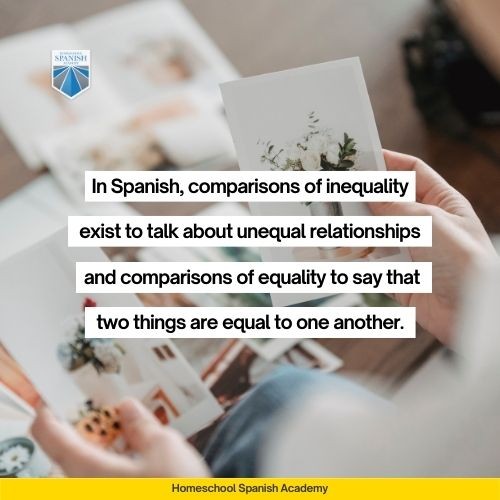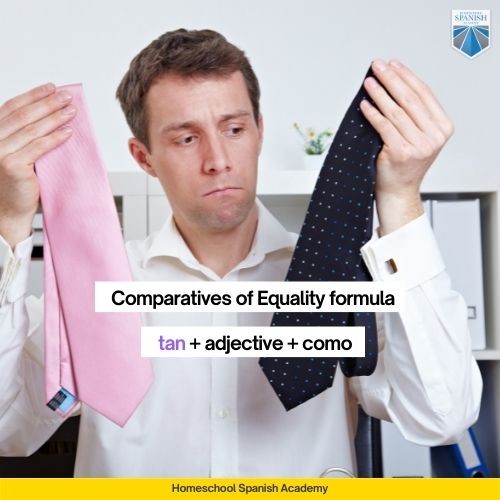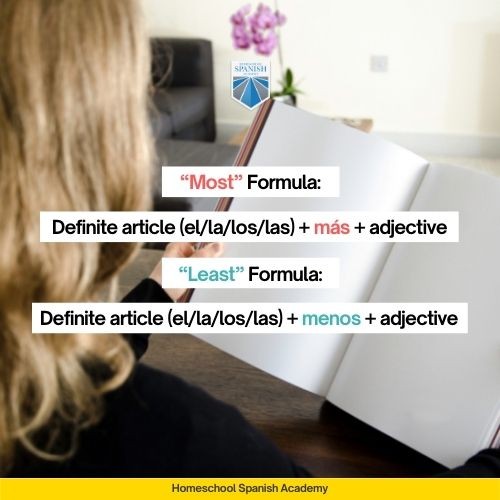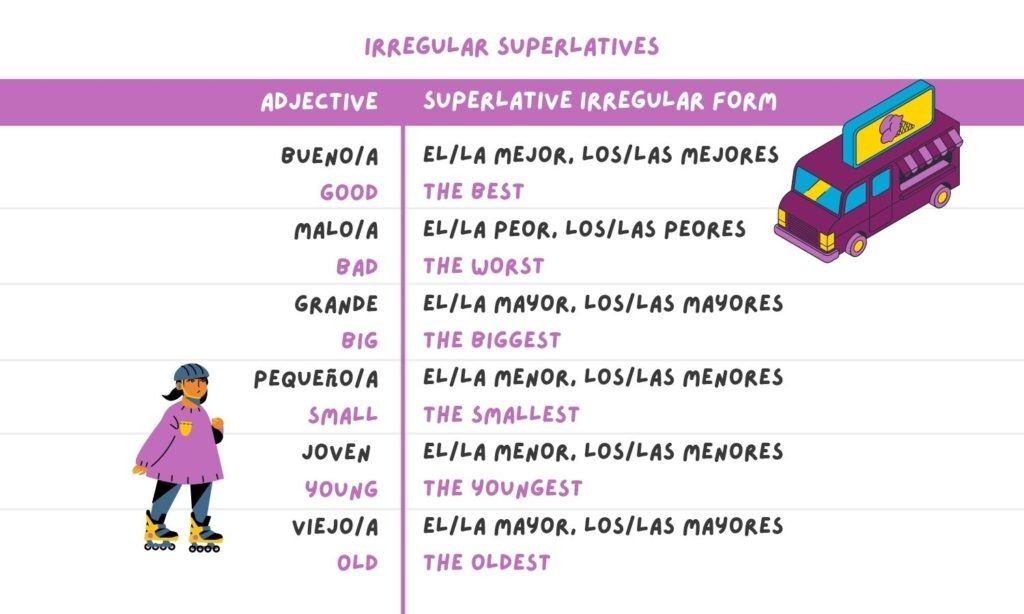Comparatives and superlatives are fundamental tools in any language, allowing you to express comparisons, preferences, and extremes. In Spanish, mastering these grammatical concepts opens up a richer and more nuanced level of communication. Are Spanish Comparatives and superlatives truly essential? Absolutely!
Consider these common phrases:
- Can you speak more slowly?
- I like this one better.
- You’re the best!
- It’s the most difficult word to pronounce!
As you can see, comparatives and superlatives are woven into everyday conversation. Learning how to use them in Spanish is not just helpful—it’s crucial for fluency.
This guide will delve into Spanish comparatives and superlatives, making them clear and easy to understand. We’ll cover comparisons of inequality, equality, irregular forms, and superlative constructions, ensuring you gain a solid grasp of this key aspect of Spanish grammar.
Understanding Spanish Comparatives and Superlatives
In Spanish grammar, comparative adjectives are used to highlight the differences or similarities between two items. We use them to compare two nouns, indicating whether one is greater, lesser, or equal to the other in a specific quality. Spanish comparatives fall into two main categories:
- Comparisons of inequality: Used to express that two things are not equal in a particular attribute.
- Comparisons of equality: Used to indicate that two things are the same in a specific attribute.
Superlative adjectives in Spanish take comparison a step further. They are employed when you want to compare three or more items and identify the one that is “the most” or “the least” in a given characteristic. Superlatives help you express the highest or lowest degree of a quality within a group.
If you want to brush up on your adjective basics before diving into comparatives and superlatives, take a look at this helpful resource: A Comprehensive Guide to Spanish Adjectives.
Spanish Comparatives of Inequality: More or Less Than
Comparisons of inequality in Spanish are used to show that one thing possesses more or less of a certain quality than another. In English, we often use “more” or “-er” endings to form comparatives (e.g., “more intelligent,” “taller”). Spanish offers a similarly straightforward system.
To say something is “more” or “less” than something else in Spanish, simply follow these formulas:
1. “More Than” Formula:
más + adjective + que
2. “Less Than” Formula:
menos + adjective + que
Remember, a key aspect of Spanish grammar is adjective agreement. The adjective used in the comparative structure must agree in gender and number with the noun it modifies.
Let’s look at some examples to illustrate these formulas:
- Mi mamá es más baja que la tuya. (My mom is shorter than yours.) – baja (short) agrees with mamá (mom, feminine, singular)
- Yo soy más alto que tú. (I am taller than you.) – alto (tall) agrees with yo (I, masculine assumed in this context, singular)
- Rita es menos alta que su hermana. (Rita is less tall than her sister.) – alta (tall) agrees with Rita (feminine, singular)
- Su perro es más listo que el mío. (His dog is smarter than mine.) – listo (smart) agrees with perro (dog, masculine, singular)
- Estos tacos son menos caros que los de la esquina y más deliciosos. (These tacos are less expensive than the ones on the corner and more delicious.) – caros (expensive) and deliciosos (delicious) agree with tacos (masculine, plural)
To express “not as… as,” essentially negating equality, Spanish uses a slightly different structure, employing the basic adjective form:
no + verb + tan + adjective + como
- Yo no soy tan inteligente como tú. (I’m not as smart as you.)
- Su gato no es tan perezoso como el mío. (His cat is not as lazy as mine.)
Irregular Spanish Comparatives: Simpler Than You Think
While most Spanish comparatives follow the más/menos + adjective + que pattern, there are a few important irregular forms. The good news is that these irregular comparatives are often considered easier to use because they eliminate the need for más or menos. You simply need to memorize these specific forms.
Here’s a table of the most common irregular comparatives in Spanish:
| Adjective | Comparative Irregular Form | English Equivalent |
|---|---|---|
| bueno/a (good) | mejor | better |
| malo/a (bad) | peor | worse |
| grande (big/large) | mayor | bigger/larger |
| pequeño/a (small) | menor | smaller |
| joven (young) | menor | younger |
| viejo/a (old) | mayor | older |






Notably, for grande, pequeño, joven, and viejo, you can also use the regular forms (más grande, más pequeño, más joven, más viejo), and they are frequently heard in everyday Spanish. However, using the irregular forms mayor and menor is often considered more sophisticated, especially in formal contexts.
Irregular comparatives do not change based on gender, but they still need to agree in number with the noun they modify.
Examples:
- Ella es mejor en español que yo. (She is better at Spanish than I am.) – mejor (better) is used directly.
- Ellos son mejores en todo. (They are better at everything.) – mejores (better – plural form) agrees with Ellos (They).
For a deeper dive into these exceptions, explore this resource: Irregular Comparatives in Spanish Adjectives and Adverbs.
Spanish Comparatives of Equality: As… As
Comparisons of equality in Spanish express that two things are equal or similar in a specific quality. When used with adjectives, the key word to remember is tan (so/as).
The formula for Spanish comparatives of equality is:
tan + adjective + como
Again, remember adjective agreement. The adjective following tan must agree in gender and number with the noun it describes.
Examples:
- Ella es tan trabajadora como su madre. (She is as hardworking as her mother.) – trabajadora (hardworking) agrees with Ella (She, feminine, singular).
- Ellas son tan parlanchinas como sus primas. (They are as talkative as their cousins.) – parlanchinas (talkative) agrees with Ellas (They, feminine, plural).
- Él es tan guapo como mi actor favorito. (He is as handsome as my favorite actor.) – guapo (handsome) agrees with Él (He, masculine, singular).
- Ellos son tan atrasados como nosotros. (They are as behind the times as we are.) – atrasados (behind the times) agrees with Ellos (They, masculine, plural).
Another way to express comparisons of equality is by using igual de (just as) instead of tan. The formula remains largely the same:
igual de + adjective + como
- Ella es igual de trabajadora como su madre. (She is just as hardworking as her mother.)
To further understand the nuances of tan and its close relative, tanto, you might find this article helpful: Tan vs Tanto: What’s the Difference?.
Spanish Superlatives: The Most and The Least
Superlatives in Spanish are used when you want to compare three or more nouns and identify which one is “the most” or “the least” in a particular quality. The structure is similar to comparatives of inequality, but with the addition of a definite article.
Here are the formulas for forming superlatives in Spanish:
1. “The Most” Formula:
Definite article (el/la/los/las) + más + adjective
2. “The Least” Formula:
Definite article (el/la/los/las) + menos + adjective
Remember that both the definite article and the adjective must agree in gender and number with the noun they describe.
Examples:
- Mi hermano es el más alto de su salón. (My brother is the tallest in his class.) – el (masculine singular definite article) and alto (tall, masculine singular) agree with hermano (brother).
- Ana es la más baja del grupo. (Ana is the shortest in the group.) – la (feminine singular definite article) and baja (short, feminine singular) agree with Ana.
- Ellos son los más ruidosos. (They are the loudest.) – los (masculine plural definite article) and ruidosos (noisy, masculine plural) agree with Ellos (They).
- Ellas son las más amables de aquí. (They are the nicest ones here.) – las (feminine plural definite article) and amables (nice, feminine plural) agree with Ellas (They).
Irregular Spanish Superlatives: Building on Irregular Comparatives
Just as with comparatives, Spanish has irregular superlatives for the same set of adjectives: bueno, malo, grande, pequeño, joven, and viejo. These irregular superlative forms are directly related to their irregular comparative forms. In fact, you simply take the irregular comparative form and add the definite article in front.
The formula for irregular superlatives is:
Definite article (el/la/los/las) + superlative irregular adjective
Here’s a table summarizing the irregular superlative forms:
| Adjective | Superlative Irregular Form | English Equivalent |
|---|---|---|
| bueno/a (good) | el/la mejor, los/las mejores | the best |
| malo/a (bad) | el/la peor, los/las peores | the worst |
| grande (big/large) | el/la mayor, los/las mayores | the biggest/largest |
| pequeño/a (small) | el/la menor, los/las menores | the smallest |
| joven (young) | el/la menor, los/las menores | the youngest |
| viejo/a (old) | el/la mayor, los/las mayores | the oldest |
Remember, similar to irregular comparatives, you can also use the regular superlative forms (el más grande, la más pequeña, el más joven, los más viejos) for grande, pequeño, joven, and viejo. Both forms are considered correct.
Irregular superlatives must also agree in gender and number with the noun.
Examples:
- Ellas son las mejores amigas. (They are best friends.) – las mejores (the best friends – feminine plural)
- ¡Ustedes son los peores! (You are the worst!) – los peores (the worst – masculine plural)
- ¡Te esperan las mayores ventajas! (The biggest advantages await you!) – las mayores (the biggest – feminine plural)
- Son las menores en este grupo pero las más altas. (They are the youngest in this group but the tallest.) – las menores (the youngest – feminine plural), las más altas (the tallest – feminine plural)
- Mis abuelos son los mayores en su edificio. (My grandparents are the oldest in their building.) – los mayores (the oldest – masculine plural)
Lo Mejor and Lo Peor: Gender-Neutral Superlatives
Spanish also uses the neuter article lo with mejor and peor to express a general superlative, meaning “the best thing” or “the worst thing” in a general sense, without referring to a specific noun.
- Es lo peor que me ha pasado hasta ahora. (It’s the worst thing that has happened to me so far.)
- No tener que estudiar es lo mejor. (Not having to study is the best thing.)
- ¡Eres lo mejor que me pudo pasar en mi vida! (You are the best thing that could have happened to me in my life!)
You can also use lo with más + adjective to express “the most” in a general, gender-neutral way.
- Es lo más fácil del mundo. (It’s the easiest thing ever.)
Expressing Extreme Qualities: The -ísimo Suffix
Spanish provides another elegant way to express the superlative degree of an adjective: by adding the suffix -ísimo (feminine -ísima, plural -ísimos/ísimas). This suffix intensifies the adjective, translating to English equivalents like “very,” “extremely,” “super,” or “so.”
- ¡Eres belísima! (You are very beautiful!)
- ¡Este pastel es buenísimo! (This cake is so good!)
There are some spelling adjustments to note when using -ísimo:
- Adjectives ending in -ble change to -bilísimo:
- Ella es amabilísima. (She’s super nice.)
- Me siento miserabilísimo. (I feel really miserable.)
- Adjectives ending in -n, -dor, or -or change to -císimo:
- ¡Eres jovencísimo! ¿Qué haces aquí? (You’re very young! What are you doing here?)
- Mi hija es habladorcísima. (My daughter is extremely talkative.)
- Many adjectives with an r in the final syllable take the ending -érrimo:
- libre (free) – libérrimo (extremely free)
- célebre (famous) – celebérrimo (extremely famous)
- Este colegio es libérrimo. (This school is extremely liberal.)
- Él es celebérrimo. (He’s super famous.)
Spanish Comparatives and Superlatives: Key Takeaways
Let’s summarize the main points about Spanish comparatives and superlatives:
- Use más + adjective + que to say something is “more than” something else.
- Use menos + adjective + que to say something is “less than” something else.
- Use tan + adjective + como to say something is “as… as” something else.
- For superlatives (“the most” or “the least”), add a definite article (el/la/los/las) before más or menos.
- Master the irregular comparative and superlative forms for bueno, malo, grande, pequeño, joven, and viejo.
- Use the suffixes -ísimo, -císimo, and -érrimo to express extreme qualities.
Practice Makes Perfect: Using Spanish Comparatives and Superlatives
Hopefully, you now see that Spanish comparatives and superlatives are más fácil de lo que pensabas (easier than you thought). Like any grammar topic, practice is key to solidifying your understanding and making these structures automatic in your speech and writing.
Think about your motivations for learning Spanish. Do you dream of traveling to Spanish-speaking countries? Perhaps you want to connect with Spanish-speaking communities in your own neighborhood? In the United States alone, there are over 41 million native Spanish speakers who enrich the cultural landscape.
Start practicing today! Consider taking a free trial class at Homeschool Spanish Academy. Our certified, native Spanish-speaking teachers from Guatemala are ready to help you achieve your fluency goals. Practice using Spanish comparatives and superlatives in real conversations, and explore our affordable pricing and flexible programs to continue your Spanish learning journey!
Join Our Community: Real Results in Spanish Learning
Every month, Homeschool Spanish Academy hosts over 40,000 classes, helping students like you achieve their Spanish language goals. Here are just a few stories from our satisfied learners:
“Getting to know wonderful teachers who care about me and my growth in language and education. Evelyn Gomez and Erick Cacao are two of the most extraordinary people I have ever met, and talking with them in Spanish at the beginning of classes is always so fulfilling and greatly contributes to my happiness, joy, and wellbeing.”
– Abby
“HSA offers very affordable, quality, one on one classes with a native speaker. My son has greatly benefited from taking classes. We have seen his confidence increase as well as his pronunciation improve, because he learns from a native Spanish speaker. HSA has quick, personal customer service. Our family has been very pleased with our experience so far!”
– Erica P. Parent of 1
“It’s great being able to interact with native speaking people and having a conversation with them not just doing all the work on paper. It’s also an amazing opportunity to speak with native Spanish-speaking people without having to travel to a native Spanish-speaking country.”
– Melanie
Continue Your Spanish Grammar Journey
Ready to explore more Spanish grammar topics? Here are some recommended articles to further your learning:
Spanish Grammar Articles on Spanish.Academy
By mastering Spanish comparatives and superlatives, you’re taking a significant step towards fluency and confident communication in Spanish. Keep practicing, and ¡lo harás mejor cada día! (you’ll do better every day!).